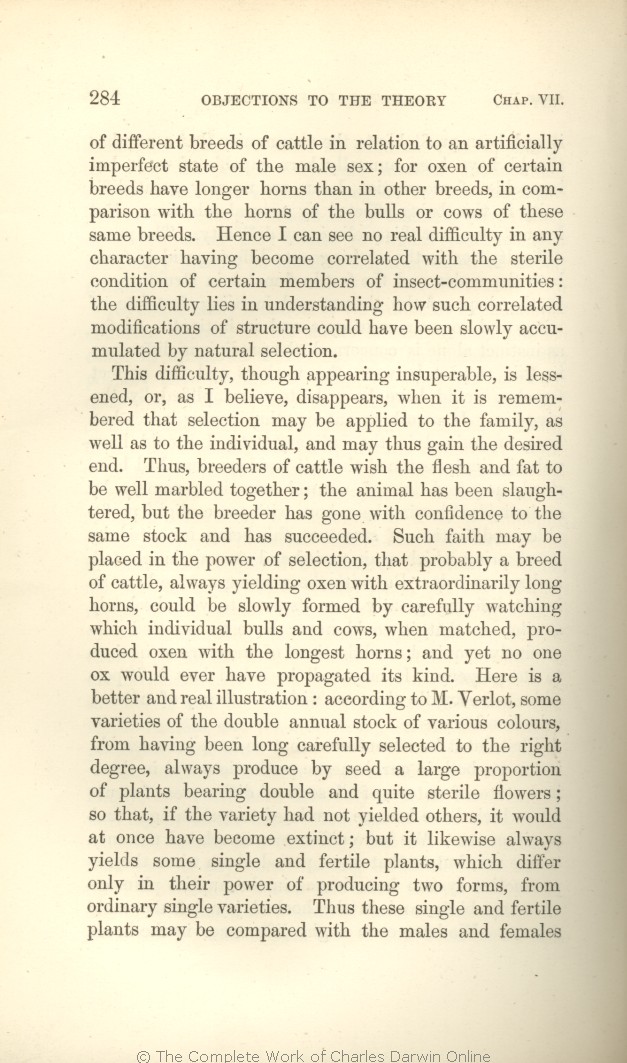This difficulty, though appearing insuperable, is
lessened, | lessened, 1859 1860 1866 1869 1872 | | les- sened, 1861 |
| 1 blocks not present in 1859 1860 1861 1866 1869; present in 1872 | | Breeders of cattle wish the flesh and fat to be well marbled together: an animal thus characterised has been slaughtered, but the breeder has gone with confidence to the same stock and has succeeded.
|
| breeders of cattle wish the flesh and fat to be well marbled together; the animal has been slaughtered, 1866 1869 |
| a well-flavoured vegetable is cooked, and the individual is destroyed; 1859 1860 1861 |
| breeder has gone with confidence to 1866 1869 |
| horticulturist sows seeds of 1859 1860 1861 |
| stock 1866 1869 | | stock, 1859 1860 | | family, 1861 |
| has succeeded. 1866 1869 |
| confidently expects to get nearly the same variety; breeders of cattle wish the flesh and fat to be well marbled together; the animal has been slaughtered, but the breeder goes with confidence to the same family. 1859 |
| confidently expects to get nearly the same variety: breeders of cattle wish the flesh and fat to be well marbled together; the animal has been slaughtered, but the breeder goes with confidence to the same family. 1860 |
| confidently expects to get nearly the same variety: breeders of cattle wish the flesh and fat to be well marbled together; the animal has been slaughtered, but the breeder goes with confidence to the same stock. 1861 |
| ..... 1866 1869 1872 | | I have 1859 1860 1861 |
| Such 1866 1869 1872 | | such 1859 1860 1861 |
| may be placed in 1866 1869 1872 |
| in 1859 1860 1861 |
| power 1866 1869 1872 | | powers 1859 1860 1861 |
| probably 1866 1869 |
| I do not doubt that 1859 1860 1861 |
| OMIT 1872 |
| could 1859 1860 1861 1866 1869 | | could, 1872 |
| be slowly 1859 1860 1861 1866 1869 |
| it is probable, be 1872 |
| would 1866 1869 1872 | | could 1859 1860 1861 |
| stock 1866 1869 | | Stock 1872 |
| of various colours, 1866 1869 |
| OMIT 1872 |
| carefully 1866 1869 | | and carefully 1872 |
| by seed 1866 1869 | by seed 1872 |
| plants 1866 1869 | | seedlings 1872 |
| so that, if the variety had not yielded others, it would at once have become extinct; but it likewise always 1866 |
| so that, if the variety had not likewise yielded others, it would at once have become extinct; but it always 1869 |
| but they likewise 1872 |
| yields 1866 1869 | | yield 1872 |
| plants, 1866 1869 | | plants. 1872 |
| which 1866 1869 | which 1872 |
| differ 1866 1869 | differ 1872 |
| only 1866 |
| from ordinary single varieties only 1869 |
| OMIT 1872 |
| their 1866 1869 | their 1872 |
| power 1866 1869 | power 1872 |
| producing 1866 1869 | producing 1872 |
| two forms, from ordinary single varieties. 1866 |
| OMIT 1872 |
| the two forms. 1869 |
| these single and fertile plants 1866 |
| the fertile plants 1869 |
| These latter, by which alone the variety can be propagated, 1872 |
| may 1866 1872 |
| producing single flowers may 1869 |
| males 1866 1869 | | fertile male 1872 |
| females 1866 1869 | | female 1872 |
|









